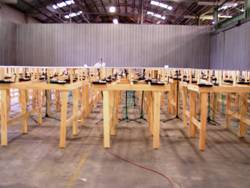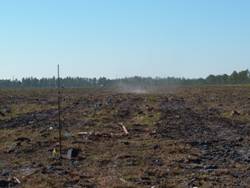Systems and Open-Source Software
|
|||||||||||||||
|
Systems
[top]
ARA is an at-scale platform for advanced wireless research to be deployed across the Iowa State University (ISU) campus, City of Ames (where ISU resides), and surrounding research and producer farms as well as rural communities in central Iowa, spanning a rural area with diameter over 60km. It serves as a wireless living lab for smart and connected rural communities, enabling the research and development of rural-focused wireless technologies that provide affordable, high-capacity connectivity to rural communities and industries such as agriculture.
CyNet: End-to-End Software-Defined
Cyberinfrastructure for Smart Agriculture and
Transportation
Our work won the Best Demo Award at the 21st NSF GENI
Engineering Conference and the Best Demo First Runner-up
Award at the 20th NSF GENI Engineering Conference.
KanseiGenie
is a federated wireless sensor network (WSN) infrastructure
for at-scale experimentation with heterogeneous wireless and
sensing platforms. It currently includes WSN infrastructures
from Ohio State University, Wayne State University, and
Oklahoma State University, and it is expected to incorporate
WSN infrastructures from other countries such as India and
China too. The system is developed as a part of our NSF GENI
project KanseiGenie.
NetEye consists of 130
TelosB motes (with IEEE 802.15.4 radios), 15 Dell Vostro
laptops (with IEEE 802.11 b/g radios), and one compute server
which are deployed in State Hall --- the Computer Science
building at Wayne State University. In addition to providing a
local facility for supporting research and educational
activities, NetEye is being connected to Kansei as a part of
the Kansei consortium; Kansei consortium is initiated to
enable experimentation across shared, widely distributed
sensornet testbeds at organizations such as Wayne State
University, The Ohio State University, Los Alamos National
Laboratory, and ETRI, Korea. NetEye and the Kansei consortium
are designed and implemented to be interoperable with NSF
GENI (i.e.,
Global Environment for Network Innovations), and, through
funding from the NSF GENI program, are being incorporated into
the national GENI facility. NetEye also provides live sensing
data (e.g., environmental noise, temperature, and humidity)
that can be used to drive experimentations and to provide
useful information about occupational health in urban
universities. ExoGENI:
Network-Agile Multi-Provisioned Infrastructure for GENI
Our contributions to Kansei were 1) designing the 210-node 802.11 network such that link and network properties in Kansei mimic those outdoor, 2) designing the experiment scheduler to enable flexible and dependable experimentation, and 3) setting up the hardware and software platforms for Kansei. To facilitate high-fidelity wireless network experimentation, in particular, we have studied both indoor and outdoor wireless link properties, and have co-designed the network system (such as signal attenuators and small form-factor omni-directional antennae) to enable high-fidelity experimentation with reconfigurable network setup (e.g., node distribution density, wireless link reliability, etc.).
Our contributions to the
project were twofold. First, to provide real-time and
reliable data transport over the IEEE 802.11b mesh network
of the ~210 Stargates, we studied the IEEE 802.11b link
properties (e.g., MAC transmission time and reliability) in
the presence of bursty event traffic, and accordingly we
designed and implemented a beacon-free routing protocol
Learn On The Fly (LOF). Instead
of using beacon packets, LOF estimates link properties based
on data traffic itself. Since it models the network state in
the presence of data traffic, LOF chooses routes that incur
shorter delay and less energy consumption than those chosen
by beacon-based protocols (e.g., those using beacon-based
ETX metric). Second, to reduce channel contention and to
balance load at the XSM mote network, we assisted in
designing the routing protocol Logical Grid Routing (LGR).
Our major contribution to the project was
designing and implementing mechanisms to transport, reliably
and in real-time, large bursts of data packets from
different network locations to a base station (one major
technical challenge of the project). With existing messaging
services, only 50% data were successfully delivered
and packet delivery was also significantly delayed, which
was insufficient for supporting application logic. To tackle
this challenge, we studied the limitations of existing
transport control techniques, and we designed a new protocol
Reliable Bursty Convergecast (RBC): to alleviate
retransmission-incurred channel contention, we introduced
differentiated contention control; to improve channel
utilization and to reduce ack-loss, we designed a
window-less block acknowledgment scheme that guarantees
continuous packet forwarding (regardless of packet as well
as ack loss) and replicates the acknowledgment for a packet.
Moreover, we designed mechanisms to handle varying ack-delay
and to reduce delay in timer-based retransmissions. With
RBC, 96% data were successfully delivered in real-time such
that the network goodput was close to optimal.
Open-Source
Software [top]
TinyOS
code for the Multi-Timescale-Adaptation (MTA) Real-Time
Routing Protocol TinyOS
code for the Reliable-Bursty-Convergecast (RBC) protocol
Reliably
fetching MAC feedback for IEEE 802.11 devices in Linux TinyOS
code for different data-driven link estimation & routing
protocols in wireless sensor networks TinyOS
code for Delay-Constrained Packet Packing in Wireless Sensor
Networks |



